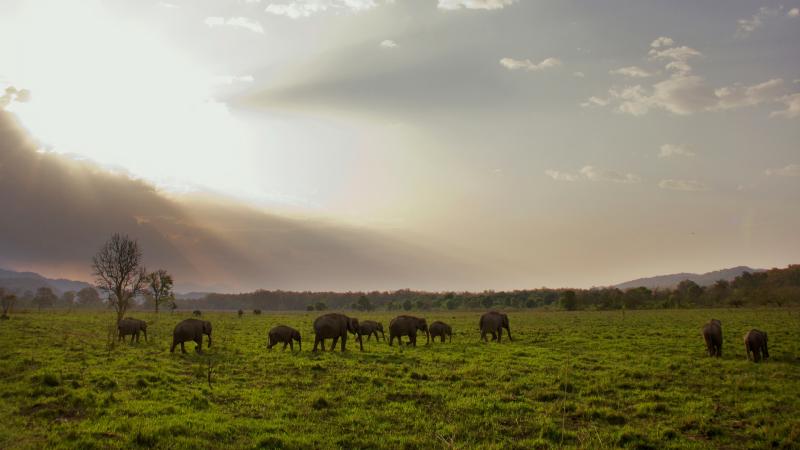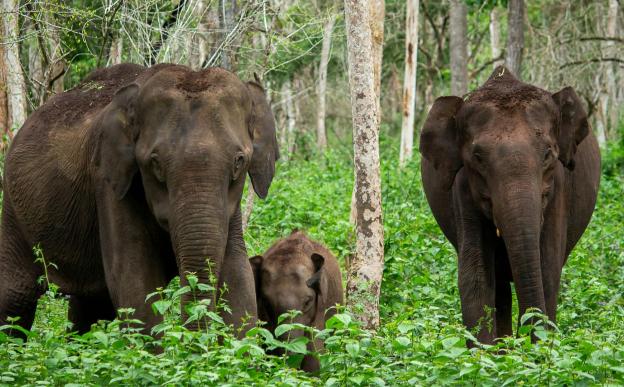
‘More the merrier’ is an adage that suits a fun-filled evening with friends with a potluck when a lot of food is up for grabs. But a single slice of tasty pizza? One would rather not share it at all! So, group size tends to change depending on the situation. Apparently, this is also true with elephants in which their group size changes often.
Elephant groups are generally led by and consist largely of females. They have a fission-fusion society like humans do, which means that members regularly join and leave the group. A group is a set of individuals seen associating together, and groups seen in the field are usually subsets of a more inclusive social unit. The most inclusive social unit in elephants is the clan.
One of the reasons for fission-fusion dynamics, where some individuals break out of a group or join back in, is the amount of resources available, like food. Larger groups afford better protection against predators, but can be maintained only when food is available in plenty. When resources are scarce or dispersed, however, members begin to compete for food, and smaller groups make more sense. This type of society is also characteristic of other species such as spider monkeys, chimpanzees, brown hyenas and spotted hyenas, and studies have shown that the groupings are affected by availability of resources.
_4.jpg)
In this study, S. Nandini, P. Keerthipriya, and T. N. C. Vidya from the Evolutionary and Organismal Biology Unit at the Jawaharlal Nehru Centre for Advanced Scientific Research (JNCASR), Bengaluru, wanted to see if seasons, which would be expected to affect abundance and dispersion of food and water, had any effect on the group size of female Asian elephants. They observed a population of these elephants at the Nagarahole and Bandipur National Parks over a period of five years and carefully identified individual females using ear, tail and body characteristics. They collected data on the associations of these females with each other during the dry and wet seasons. The results of this study were published in the journal Animal Behaviour.
The researchers found that although group sizes were larger in the dry season compared to the wet season at the population level, that was not so at the clan level. A clan is a social subunit of the population and the most inclusive social unit; the females of one clan do not interact with those of another. The researchers also found that there were stronger associations between females in the wet season than in the dry season at the population level, but no consistent differences of the same at the clan level.
“Elephants were more dispersed in the forest in the wet season and congregated near the Kabini backwaters in the dry season. Thus, seasonality seemed to affect the way in which elephants use their habitats, but not their group size or social structure within clans,” explains Dr Nandini on the findings.
Irrespective of the number of females in clans, groups within clans retained a similar average size, suggesting that there is some restriction, probably resource availability, that limits group sizes to small numbers. The fission-fusion dynamics of this population, therefore, appeared to be more for clan members to meet up and socialise with multiple clan-mates while maintaining a small group size, rather than to increase or decrease the size of the groups. One of the reasons for these extended associations could be allomothering - a kind of ‘babysitting’ where a female takes care of the calf of another, to give her some respite from the constant demands of her little one. Other reasons could be to exchange information about distribution of food and presence of predators, or for strengthening social bonds. Though the exact importance of these factors in maintaining the observed social structure is not known, the researchers plan to examine them in future.
This project was part of the Kabini Elephant Project started by Dr Vidya in 2009, to study how ecological factors and genetic relatedness affect behaviour and social organisation. “We are continuing work on understanding social organisation and looking at how resource availability shapes social structure and dominance interactions,” she concludes.
Editor's note (3 Jan 2018): The quote by Dr. Nandini was updated based on the vetted version of the article.






